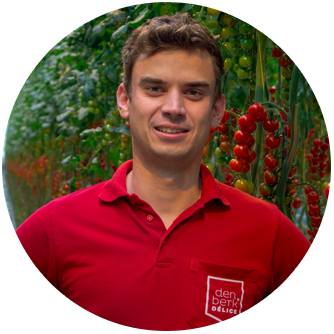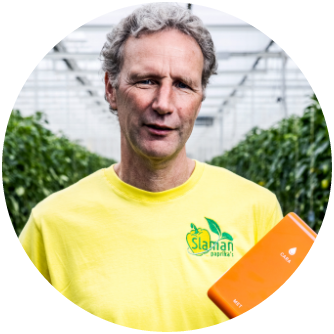‘More accurate than my gut feeling’
The tomato grower Den Berk Délice in Rijkevorsel, Belgium introduced ten CARA MET sensors in the spring of 2020. With the new insights, growing manager Lucas Aertsen soon realised that he needed to adjust his irrigation strategy.
The location in Rijkevorsel has nearly 10 hectares of cherry and cocktail tomatoes under lighting. Until last year, the irrigation at the company was controlled on the basis of knowledge and experience, supplemented with weight measurement data, says growing manager Lucas Aertsen.
“There had been sensors on the market for a long time, of course, and we’d actually worked
with some of them in the past. But earlier generations were quite susceptible to fouling, so
they weren’t very reliable. You had to keep checking them and that’s really not what you
want when you buy a sensor.”
Detailed picture
Aertsen says that their experiences with the CARA MET sensor of SenseNL are much more positive. In the spring of 2020, Den Berk Délice started using one base station with ten sensors. To get a better understanding of both the system and the dynamics of the water balance inside the slabs, they were spread across just two slabs. “That’s not how it’s supposed to be, of course, but it gave me a very detailed picture of what happens in those two slabs through the day. During the hot spell in May/June, I soon discovered that the EC in the slab was structurally much higher around midday than I myself had thought. So the sensors are more accurate than my gut feeling. In that kind of weather, I normally start reducing the dose size at half past one, but the data I obtained made me decide to wait a bit longer.”
Aertsen is now convinced that the tomatoes have performed better with the CARA MET sensors than they would have without them. Last year the sensors were mainly used to gain knowledge and experience. Now the sensors have all been allocated their own slab, spread across the section. “This is a new learning phase, but by now I’m confident enough to rely on the data. These slab sensors give me a lot more certainty. They’re a useful tool for making sound decisions, so that the crop can perform even better.”
This interview is a summary of an article previously published in trade journal Onder Glas (In Greenhouses).

Lucas Aertsen

René Beerkens
Hoogendoorn Growth Management
‘Avoiding mistakes is the biggest gain’
In 2020 Hoogendoorn Growth Management and the AuTomatoes team won Wageningen University’s Autonomous Greenhouse Challenge with a convincing margin. An important factor in this victory was the use of the CARA MET sensors, says consultant René Beerkens.
During the Autonomous Greenhouse Challenge the AuTomatoes team achieved the highest net profit using the least resources. The professional jury also rated their AI strategy as the best. The team applied the Plant Empowerment principles in their algorithms to provide optimum support for the plant balances and to produce a strong, well-balanced crop, says consultant René Beerkens of Hoogendoorn. For this it was important to generate as much data as possible: that is to say, of course, reliable data. He explains that this goal was achieved thanks partly to the CARA MET sensors inserted in the substrate and that the SenseNL sensors gave a lot of insight. “With just one box of ten CARA MET sensors, we learned more in one day than we’d learned in the years before.”
Super jump
Beerkens says that it’s crucial to have accurate information about moisture content, EC and temperature in order to grow a crop autonomously. “Irrigation is a plant’s first basic need. This has to be correct and you have to make sure there are no blunders. Because it’s not so much a matter of doing everything as perfectly as possible, but more just making as few mistakes as possible. That’s where you can make the biggest gains.” He adds that this was also one of the most important lessons. “We’re lord and master of what happens above the ground, but we really don’t know anything about below the ground. Using sensors gives us that reliable information and we were able to make a super jump. I can confidently say that without using the sensors in the root environment, we could never have achieved such a good result as we did.”
Reliable and stress-free
Beerkens describes the various advantages offered by the CARA MET sensor: “The excellent price is absolutely an added value, because you get more sensors and pay less. It’s also important that the sensors are wireless and plug & play, so that they’re easy to install in the greenhouse. Sensors are often wired, which makes them less flexible. Having multiple wireless sensors distributed around the greenhouse means that in the end you get much
better insight.” This is very important, he thinks, given the decreasing number of people with the necessary knowledge of growing, and the fact that new generations don’t want to be thinking 24/7 about what’s going on in the greenhouse. “They want stress free processes, so data-driven growing is becoming a must. And this can also be reliable, thanks to advanced sensors like the CARA MET.”
Peace of mind
In addition to insight into moisture content, EC and temperature, Beerkens would also like data about drain, pH and oxygen. “Then you’d have even more control over the water management. But even without that information, the CARA MET already offers the peace of mind that growers need.”
‘Control based on data is a learning process’
Slaman Paprika’s in Zevenhuizen (Netherlands) is a grower with four hectares of yellow sweet peppers. Over the years, Alfons Slaman has gained experience with various measuring instruments to improve the performance of his crop. He recently started using the CARA MET sensor at his company and is learning more about what goes on in the root zone.
A high yield together with good quality. That’s the goal of Slaman Paprika’s. “The top priority is always that the crop has to grow well. But if you want to do that a bit better every time, you need some helpful tools,” says Alfons Slaman. So in 2006 he started with the Spider system, which used two sensors and a separate PC to measure the moisture content in the slab. He then used a device for monitoring plants in the greenhouse for a while: small clips were attached to the leaf and measured aspects like the leaf temperature. “But at a certain point I just got swamped with charts and diagrams, it was too much information,” he explains. Then in 2019 he started testing a sensor designed to take sap flow measurements. “An expensive solution that gave you even more charts and was difficult to read. It was just a bit too makeshift and too sensitive, and you were still left with the question: what are you supposed to do with all the data and how do you translate it into practice? But it shows that we’ve been working with data for many years, and looking for solutions that will help us to improve.”
Intervene when necessary
A reliable successor to the Spider system for measuring the moisture content wasn’t available for a long time, says Slaman, even though he needed to have more insight into the slab. “You want to grow your crop in a certain way, with enough irrigation but not leaving it too wet overnight. Another difficulty is that we’re increasingly confronted with extreme temperatures in the spring and summer, which means you have to be able to intervene in the irrigation. But without precise data about the moisture content it’s very difficult to control this. So you can cause an awful lot of damage in a short time.” Then he came across the CARA MET. Using this sensor in his greenhouse has provided stability, he explains. “At the moment I don’t have enough experience with the CARA MET to completely control the irrigation on that basis, but I certainly use the insights to learn what the effect of a specific irrigation method could be, and to intervene when necessary. That’s a learning process.”
What especially appeals to Slaman is that the CARA MET sensor offers more measuring points and can be inserted better into the substrate, so it gives a more accurate picture than other sensors. He currently still uses a standard setting for irrigation and views the data via the LetsGrow and SenseNL platforms. When the CARA MET sensor can be linked to his climate computer in the near future, he says that he will also be confident enough to really control the irrigation on the basis of the data. “Yes, in time, when I’ve gained more experience with it, I will be confident to do that. Then when the climate computer receives a signal from the CARA MET sensor, I will be able to base the irrigation on this and will also trust that the data collected by the sensors is reliable. Practice will show exactly how many sensors I will ultimately need for that. At the moment, CARA MET is mainly helping me to determine better when I should give the last irrigation dose of the day.”

Alfons Slaman
Slaman Paprika’s

Dr. Max Hilhorst
‘Reliable in high EC regions’
The technology on which the CARA MET sensor is based was devised by the renowned researcher Dr. Max Hilhorst way back in the 1990s. He developed a unique method for reliably measuring the moisture content in the root zone. He was therefore far ahead of his time, laying a solid foundation for the future.
It actually started with the WET sensor, which was similar to many sensors at that time but of a higher standard, says Hilhorst. “It was a nice, compact sensor that worked well up to 3 microsiemens. There were companies that somehow managed to stretch the sensor slightly to reach higher, but in a production environment this sensor was really only reliable up to around 3 microsiemens.”
Conductivity
Hilhorst explains what the challenges were in terms of technology. “The problem is that you want to measure the capacity, which is related to the moisture content. The interfering factor is the soil’s conductivity, which is related to both moisture content and EC. The challenge is therefore to be able to measure that moisture content without interference from the conductivity. To accurately measure the moisture content, you need to distinguish – from the electrical perspective – between the current due to the soil’s capacity and the current due to the soil’s conductivity. The sensor that we developed back then had two pins, and between those pins you have a capacity and a conductivity. The current due to the conductivity is sometimes ten to a thousand times higher than the current due to the capacity. This means that it’s a lot more difficult to measure the one than the other.” A second challenge was the high frequency at which you’re measuring, he continues. “At those frequencies, the wavelength in the water of the soil is centimetres in length. So even just a small wire of a couple of millimetres will have a big influence on the signal.”
Hilhorst managed to solve both of these challenges, although at first he ran into limitations caused by the chip technology available in those days, which originated in mobile telephony. This was a problem that he actually tackled a few years later, partly by developing a unique algorithm. “The technology was still the same, but the algorithm offers the excellent characteristics that are now available to us. The very outdated chip was also replaced by. self-built hardware. So we now measure the signals in a completely different way than we did back then with the chip. But from the technical point of view, this process is similar.”
Cheap and reliable
In the meantime, Hilhorst was commissioned to develop a wireless pot sensor that was printable and made use of RFID technology. “It was a sensor that was relatively cheap and reliable up to 2 or 3 microsiemens. Combining this RFID sensor with the improved MET sensor resulted in the birth of the CARA MET sensor, and we’re now able to measure cheaply and also reliably in the high EC regions between 4 and 10 EC: something that other sensors still can’t do,” says Hilhorst. He ultimately sold the unique technology to SenseNL, which further developed the sensor with a focus on stone wool. This created an even greater distinction from other sensors. “Moisture content and EC are measured at different frequencies. From those two numbers you can’t automatically calculate the EC of the pore water,” he explains. “To do that, you need to measure moisture content and EC at the same frequency. We’re the only ones who do this, thanks to a formula that we use in the hardware. This is another way that the CARA MET is especially unique.”
Design
A design agency helped to give the CARA MET sensor its state-of-the-art look. A good choice, thinks Hilhorst. “Growers see all kinds of sensors and will often choose on the basis of appearance. The CARA MET is an attractive and eye-catching sensor, and the design does justice to the advanced technology used in the sensor.” He is happy with SenseNL’s choice and is proud of the end result.
Pot sensor and soil sensor
SenseNL is still drawing on Max Hilhorst’s expertise. For instance, the two of them are also developing a sensor for open-soil crops, and after the summer of 2021 a variant of the CARA MET sensor for measurements in plant pots will be introduced. This pot sensor is currently being tested and validated by Hilhorst. The technology is almost the same, but the casing will be different. An extra feature of the pot sensor is that it will show the field capacity: the maximum moisture content that the soil can hold. “I have high expectations of those new sensors, which will also be unique for their kind,” says Hilhorst. “Because making a sensor that works is one thing, but making a sensor that works in practice is quite something else.”